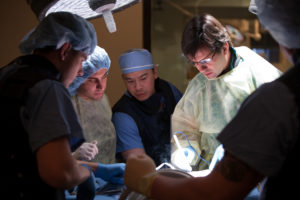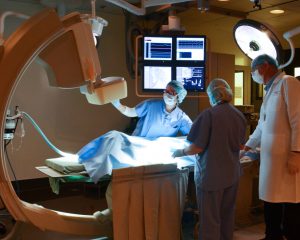As industries of all shapes and sizes continue to evolve embracing remote work models and various levels of return to travel for business, medical technology innovation and critical supporting service providers are not only working through pent up demand for delayed projects from 2020 and 2021, but also striving to advance technologies that reduce cost and improve patient outcomes developed much more recently.
What is the current state of preclinical testing of new medical technologies, drugs and biologics? GCMI Director of Scientific Affairs shares his perspective and insights here.
At the highest level, how would you describe the state of preclinical work at this moment in time?
“The volume of preclinical work remains very high compared to pre-2020 averages or standards. We are seeing higher demand for GLP studies as a ‘precautionary measure’ in case a regulatory body asks for additional data. We believe this is due in part because sponsors believe the potential reward for approval acceleration is worth the risk and additional expense related to GLP versus non-GLP studies.
“Demand for GLP studies at GCMI and T3 Labs was up nearly 100% in 2021 compared to 2019.
“Conversations with our sponsors are happening much earlier in the product or technology development timeline, which is beneficial, if not essential today given preclinical capacity limitations, high demand and potentially long lead times for required procedure supplies and materials.”
Cardiology, orthopedics and neurology technologies lead the way
“Cardiology has always been a big part of our preclinical business and continues to be so, especially technologies and therapeutics to treat heart failure. We are seeing more ‘ECMO’ and ‘LVAD’ devices of late, specifically technologies seeking to increase the amount of time indicated for their device and continuing miniaturization of those devices.
“We are doing more work in the neurology space including devices for deep brain stimulation and thrombectomy.
“Demand for preclinical services for orthopedic devices has also returned after a precipitous drop off during the height of the Covid-19 pandemic ‘shut down,’ and as associated demand for elective procedures returns as well.”
Pre-planning and regulatory engagement changes should stick
 “Nothing has changed regarding longer timelines and the very high importance of advance planning, not just with the preclinical CRO itself, but for scarce resources and time commitments among histologists, pathologists and contract surgeons in high demand.
“Nothing has changed regarding longer timelines and the very high importance of advance planning, not just with the preclinical CRO itself, but for scarce resources and time commitments among histologists, pathologists and contract surgeons in high demand.
“Planning for preclinical work farther in advance will stick, which is a very good thing for the medtech innovation ecosystem.
“And more sponsors are coming to us with U.S. FDA regulatory feedback already in hand thanks to the agency’s ‘Q-SUB’ process. We used to have to encourage that as an immediate follow on to initial conversations with our customers or sponsors. They are now coming to us with that direct regulatory insight in hand more often than not, which is a fantastic industry advancement thanks largely to the way the U.S. FDA is supporting medtech innovators at earlier and earlier stages of their development and commercialization endeavors.”
Materials and supply acquisition retains high uncertainty, variability
“In many cases, we won’t know about a material, supply or product’s availability until we actually place the order. Those issues are also highly dependent upon the specific technology. Compared to a few months ago, access and acquisition to materials and supplies is improving, but remains hit-or-miss. Variability on availability of materials and supplies for preclinical studies will remain high on either end of the spectrum.
“For example, one factory that produced 90 percent of the world’s contrast for angiography shut down in April making acquisition of contrast a massive ‘choke point’ for preclinical studies that required them.
“This again underscores the importance of advance planning for preclinical work and contacting us as early in the process as possible to have as much in place as possible when it’s fully ‘go time.’
How have Covid related protocols changed for GCMI – particularly of interest in light of the currently dominant BA.5 variant?
“We wear masks in the operating room, encourage employees to work remotely when possible and have some of the best ventilation equipment available at our facility. Fewer people are coming to work or to the facility when sick, which is always a good thing, especially because our operating rooms are scheduled months in advance and it’s critical for us to remain fully staffed with healthy team members.
“As I think we’ve seen across industries, improvements in remote collaboration including our own staff and sponsors who may not be able to travel for a procedure have generated cost and efficiency gains regardless of who’s actually in the building and who is elsewhere.
The most important things to know if you’re shopping or preparing for preclinical work in the next 12 months
 “Histology is typically the last thing the team and the sponsor waits on. Get them involved very early because their timelines can be longer than the balance of the preclinical team’s, at times as long as six months from data delivery to histology result returns, compared to two or three months historically. Get every contributing scientist required well in-line during the planning phase of preclinical work to ensure all are as ready to receive and analyze data when it’s available as possible.
“Histology is typically the last thing the team and the sponsor waits on. Get them involved very early because their timelines can be longer than the balance of the preclinical team’s, at times as long as six months from data delivery to histology result returns, compared to two or three months historically. Get every contributing scientist required well in-line during the planning phase of preclinical work to ensure all are as ready to receive and analyze data when it’s available as possible.
“If you are not familiar with the FDA’s changes to the Q-SUB process, get educated or consult a regulatory expert as soon as possible. We have seen the benefits of those changes and the associated, early stage feedback for sponsors, based on dozens of studies we have completed. With that feedback in hand in advance of preclinical work, by the time a sponsor, especially an early stage, research or clinician innovator is ready to start study, all concerned have a better idea of what it should look like. Those studies are always more well planned, all concerned are more prepared and the FDA is already on board with the preclinical study protocol and end points.”
Editor’s note: Related – Evidence of a sizeable shift in regulatory strategy for medtech innovators via our colleagues at Southeast Life Sciences
“Not long ago, CE mark achievement in Europe was almost always an easier market entry point,” Ron said. “That has changed to the point that today regulatory approval in Europe is much more difficult as the regulatory bodies there undergo a significant transformation. There is a great deal that is not known yet about practical interpretations of new regulations. This puts levels of limitations on companies’ abilities to provide the right information into European regulators’ hands that might make a United States first strategy much more attractive.”
If you are evaluating your readiness for preclinical work, or are ready to get started, it’s never too early to start the conversation. Contact our team via the form below.
